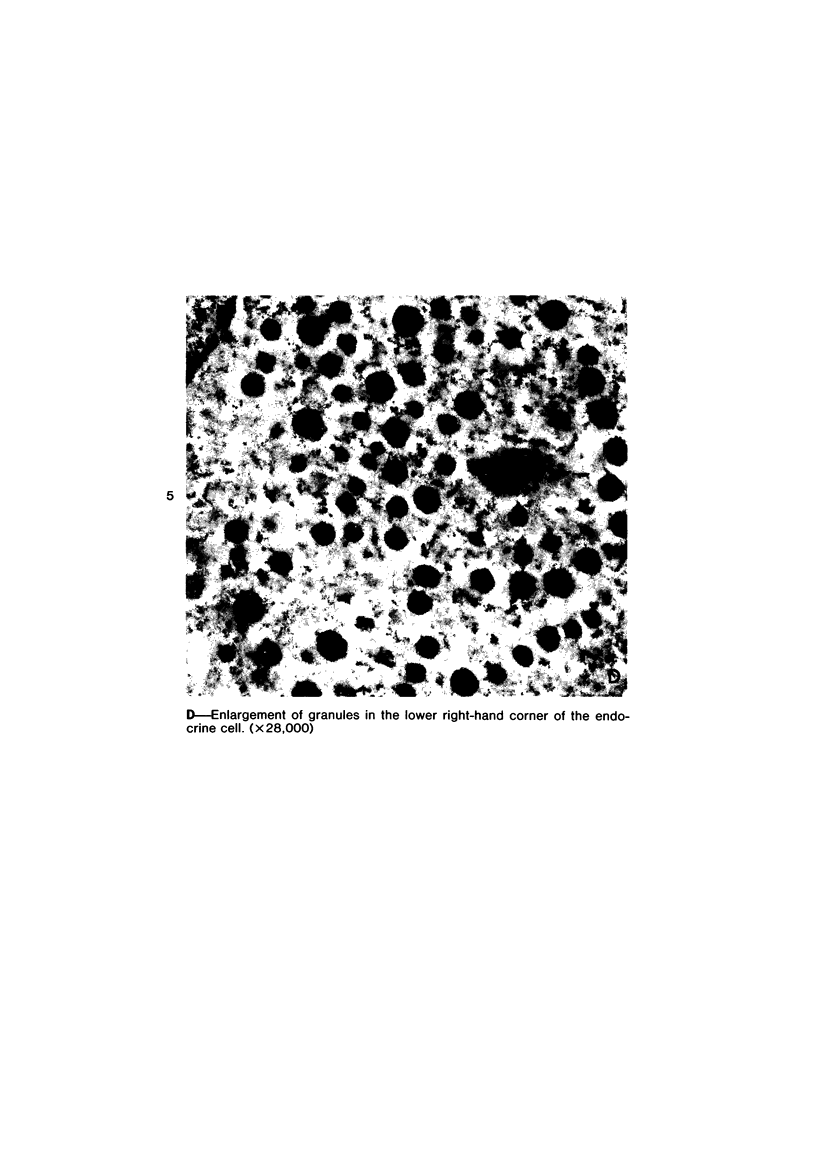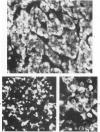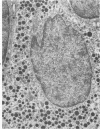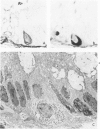Abstract
Three nonargentaffin rectal carcinoids have been investigated immunohistochemically. In one case most tumor cells reacted with antiglucagon sera as well as with antiglicentin, antibovine pancreatic polypeptide (BPP), and antihuman pancreatic polypeptide (HPP) sera; they were identified ultrastructurally as L cells. Another case showed glucagon-, glicentin-, and BPP-immunoreactive cells but lacked HPP immunoreactivity. In the third case glucagon- and glicentin-immunoreactive cells were well represented, while PP immunoreactivities were scarce. Parallel investigations of human rectal and sigmoid mucosa showed numerous cells reacting with glucagon, glicentin, and BPP antisera, most of which lacked HPP immunoreactivity. Cells reacting with glucagon and glicentin antisera, while lacking PP immunoreactivities, were also found. Thus, both tumor and nontumor cells produce glucagonlike immunoreactive (GLI) peptides--one of which may be glicentin or a related molecule--as well as PP-related sequences, although differing histochemically and ultrastructurally from glucagon or PP cells of the human pancreas. It is concluded that nonargentaffin rectal carcinoids are histogenetically linked to nonargentaffin endocrine cells of the human rectum.
Full text
PDF











Images in this article
Selected References
These references are in PubMed. This may not be the complete list of references from this article.
- Adrian T. E., Bloom S. R., Bryant M. G., Polak J. M., Heitz P. H., Barnes A. J. Distribution and release of human pancreatic polypeptide. Gut. 1976 Dec;17(12):940–944. doi: 10.1136/gut.17.12.940. [DOI] [PMC free article] [PubMed] [Google Scholar]
- Alumets J., Håkanson R., Ingemansson S., Sundler F. Substance P and 5-HT in granules isolated from an intestinal argentaffin carcinoid. Histochemistry. 1977 Jun 8;52(3):217–222. doi: 10.1007/BF00495858. [DOI] [PubMed] [Google Scholar]
- Alumets J., Sundler F., Håkanson R. Distribution, ontogeny and ultrastructure of somatostatin immunoreactive cells in the pancreas and gut. Cell Tissue Res. 1977 Dec 28;185(4):465–479. doi: 10.1007/BF00220651. [DOI] [PubMed] [Google Scholar]
- Black W. C., 3rd Enterochromaffin cell types and corresponding carcinoid tumors. Lab Invest. 1968 Nov;19(5):473–486. [PubMed] [Google Scholar]
- Bloom S. R. An enteroglucagon tumour. Gut. 1972 Jul;13(7):520–523. doi: 10.1136/gut.13.7.520. [DOI] [PMC free article] [PubMed] [Google Scholar]
- Bordi C., Togni R., Baetens D., Ravazzola M., Malaisse-Lagae F., Orci L. Human islet cell tumor storing pancreatic polypeptide: a light and electron microscopic study. J Clin Endocrinol Metab. 1978 Feb;46(2):215–219. doi: 10.1210/jcem-46-2-215. [DOI] [PubMed] [Google Scholar]
- Buffa R., Capella C., Fontana P., Usellini L., Solcia E. Types of endocrine cells in the human colon and rectum. Cell Tissue Res. 1978 Sep 5;192(2):227–240. doi: 10.1007/BF00220741. [DOI] [PubMed] [Google Scholar]
- Buffa R., Crivelli O., Fiocca R., Fontana P., Solcia E. Complement-mediated unspecific binding of immunoglobulins to some endocrine cells. Histochemistry. 1979 Sep;63(1):15–21. doi: 10.1007/BF00508008. [DOI] [PubMed] [Google Scholar]
- CALDAROLA V. T., JACKMAN R. J., MOERTEL C. G., DOCKERTY M. B. CARCINOID TUMORS OF THE RECTUM. Am J Surg. 1964 Jun;107:844–849. doi: 10.1016/0002-9610(64)90172-2. [DOI] [PubMed] [Google Scholar]
- COONS A. H., LEDUC E. H., CONNOLLY J. M. Studies on antibody production. I. A method for the histochemical demonstration of specific antibody and its application to a study of the hyperimmune rabbit. J Exp Med. 1955 Jul 1;102(1):49–60. doi: 10.1084/jem.102.1.49. [DOI] [PMC free article] [PubMed] [Google Scholar]
- Capella C., Solcia E., Frigerio B., Buffa R., Usellini L., Fontana P. The endocrine cells of the pancreas and related tumours. Ultrastructural study and classification. Virchows Arch A Pathol Anat Histol. 1977 Apr 29;373(4):327–352. doi: 10.1007/BF00432532. [DOI] [PubMed] [Google Scholar]
- Cristina M. L., Lehy T., Voillemot N., Arhan Ppellerin D., Bonfils S. Endocrine cells of the colon in Hirschsprung's and control children. Virchows Arch A Pathol Anat Histol. 1978 Apr 17;377(4):287–300. doi: 10.1007/BF00507130. [DOI] [PubMed] [Google Scholar]
- Gleeson M. H., Bloom S. R., Polak J. M., Henry K., Dowling R. H. Endocrine tumour in kidney affecting small bowel structure, motility, and absorptive function. Gut. 1971 Oct;12(10):773–782. doi: 10.1136/gut.12.10.773. [DOI] [PMC free article] [PubMed] [Google Scholar]
- Grimelius L. A silver nitrate stain for alpha-2 cells in human pancreatic islets. Acta Soc Med Ups. 1968;73(5-6):243–270. [PubMed] [Google Scholar]
- Grimelius L., Capella C., Buffa R., Polak J. M., Pearse A. G., Solcia E. Cytochemical and ultrastructural differentiation of enteroglucagon and pancreatic-type glucagon cells of the gastrointestinal tract. Virchows Arch B Cell Pathol. 1976 Apr 29;20(3):217–228. doi: 10.1007/BF02890341. [DOI] [PubMed] [Google Scholar]
- Heitz P. h., Polak J. M., Bloom S. R., Adrian T. E., Pearse A. G. Cellular origin of human pancreatic polypeptide (HPP) in endocrine tumours of the pancreas. Virchows Arch B Cell Pathol. 1976 Sep 17;21(3):259–265. doi: 10.1007/BF02899159. [DOI] [PubMed] [Google Scholar]
- Larsson L. I., Schwartz T., Lundqvist G., Chance R. E., Sundler F., Rehfeld J. F., Grimelius L., Fahrenkrug J., Schaffalitzky de Muckadell O., Moon N. Occurrence of human pancreatic polypeptide in pancreatic endocrine tumors. Possible implication in the watery diarrhea syndrome. Am J Pathol. 1976 Dec;85(3):675–684. [PMC free article] [PubMed] [Google Scholar]
- Larsson L. I., Sundler F., Håkanson R. Pancreatic polypeptide - a postulated new hormone: identification of its cellular storage site by light and electron microscopic immunocytochemistry. Diabetologia. 1976 Jul;12(3):211–226. doi: 10.1007/BF00422088. [DOI] [PubMed] [Google Scholar]
- Lemozy J. Les tumeurs carcinoïdes du rectum. Arch Fr Mal App Dig. 1973 Oct-Nov;62(7):537–568. [PubMed] [Google Scholar]
- Lin T. M., Chance R. E. Candidate hormones of the gut. VI. Bovine pancreatic polypeptide (BPP) and avian pancreatic polypeptide (APP). Gastroenterology. 1974 Oct;67(4):737–738. [PubMed] [Google Scholar]
- MAYOR H. D., HAMPTON J. C., ROSARIO B. A simple method for removing the resin from epoxy-embedded tissue. J Biophys Biochem Cytol. 1961 Apr;9:909–910. doi: 10.1083/jcb.9.4.909. [DOI] [PMC free article] [PubMed] [Google Scholar]
- Ravazzola M., Siperstein A., Moody A. J., Sundby F., Jacobsen H., Orci L. Glicentin immunoreactive cells: their relationship to glucagon-producing cells. Endocrinology. 1979 Aug;105(2):499–508. doi: 10.1210/endo-105-2-499. [DOI] [PubMed] [Google Scholar]
- Solcia E., Capella C., Buffa R., Usellini L., Frigerio B., Fontana P. Endocrine cells of the gastrointestinal tract and related tumors. Pathobiol Annu. 1979;9:163–204. [PubMed] [Google Scholar]
- Solcia E., Capella C., Vassallo G. Lead-haematoxylin as a stain for endocrine cells. Significance of staining and comparison with other selective methods. Histochemie. 1969;20(2):116–126. doi: 10.1007/BF00268705. [DOI] [PubMed] [Google Scholar]
- Solcia E., Sampietro R., Capella C. Differential staining of catecholamines, 5-hydroxytryptamine and related compounds in aldehyde-fixed tissues. Histochemie. 1969;17(3):273–283. doi: 10.1007/BF00309872. [DOI] [PubMed] [Google Scholar]
- Stefanini M., De Martino C., Zamboni L. Fixation of ejaculated spermatozoa for electron microscopy. Nature. 1967 Oct 14;216(5111):173–174. doi: 10.1038/216173a0. [DOI] [PubMed] [Google Scholar]
- Sundby F., Jacobsen H., Moody A. J. Purification and characterization of a protein from porcine gut with glucagon-like immunoreactivity. Horm Metab Res. 1976 Sep;8(5):366–371. doi: 10.1055/s-0028-1093615. [DOI] [PubMed] [Google Scholar]
- WILLIAMS E. D., SANDLER M. The classification of carcinoid tum ours. Lancet. 1963 Feb 2;1(7275):238–239. doi: 10.1016/s0140-6736(63)90951-6. [DOI] [PubMed] [Google Scholar]
- Wilander E., Portela-Gomes G., Grimelius L., Westermark P. Argentaffin and argyrophil reactions of human gastrointestinal carcinoids. Gastroenterology. 1977 Oct;73(4 Pt 1):733–736. [PubMed] [Google Scholar]






